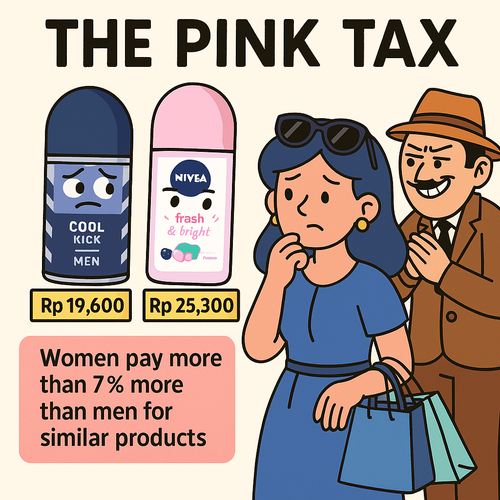The Price of Pink: How Women End Up Paying More for Less


Let’s begin with two identical shelves. On one side: a navy-blue deodorant for men. On the other: a pastel pink version for women. Same brand, same function. One is Rp 19,600. The other? Rp 25,300. This isn’t a pricing glitch. This is the “Pink Tax.” It’s not an actual tax, of course. It’s a phenomenon. A quiet markup. A strategic surcharge on products targeted to women. And once you start noticing it, you realize—it’s everywhere.
The Subtle Art of Charging More for Femininity A 2015 study by New York’s Department of Consumer Affairs broke it down like this:
And here’s what makes it more interesting: the products aren’t better. They're not more effective. They’re just pink. Or floral. Or labeled “for her.” It’s like paying a premium for the privilege of being... marketed to.
Why It Works: The Gender Brain Gap Behavioral economists have long suspected that gender influences pricing sensitivity. And studies back it up:
Men are price-resistant. Women are emotionally responsive.
One neuromarketing study even found that the hippocampus—the brain’s center for emotional regulation—is larger in women than in men. That makes women more attuned to cues like color, packaging, brand story, discounts, and even store layout. It also makes them ideal targets for emotional marketing. Which is brilliant. And a little problematic.
Packaging the Invisible Cost It gets more complex when we realize how deep this run. Retailers design women’s jeans with smaller or no pockets, not just as a fashion statement—but to encourage handbag purchases. That’s not product design. That’s ecosystem manipulation. The cost? In the U.S., women reportedly spend an extra $1,300 a year on gender-targeted goods. And 42% of women admit they’ve paid more than men for the same functional item. In a marketplace that claims to champion equality, this… doesn’t quite add up.
So, Is It Strategy or Sexism? That’s the uneasy question. From a marketer’s lens, it’s segmentation. From a consumer watchdog’s lens, it’s discrimination. And for women, it’s something that’s always been there—but rarely called out. Until now. So next time you’re in the aisle, staring at a pink package that looks oddly familiar but costs just a bit more—ask yourself: am I paying for value, or am I paying for design? Sometimes, the prettiest things come with a hidden cost.